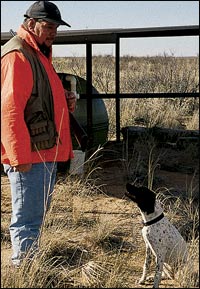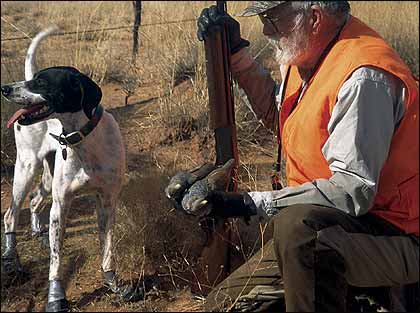Tracking Blue Quail Through The Arid Sands Of New Mexico
By William C. Parlasca
 An oasis in a sea of mesquite. All areas of Lea County, in New Mexico, are now watered by gulpers. |
The wind-shorn sand dunes seemed to churn with a dusty blue drift of feather puffs. Scaled quail--maybe more than a hundred--swarmed under the broken-down barbed-wire fence in front of us and over a sandy ridge on the other side.
We figured that our three hard-nosed bird dogs would nail at least part of the horde in a dry wash at the bottom. But the scalies' tracks appeared to go on forever, getting closer together and zigzagging like a drunk on skis. We never caught so much as a glimpse of any of those birds again. The pups' tongues dragged on the ground all the way back to the truck.
Just when you think you've got a surefire game plan for thinning the blue quail population, up jumps the devil with a new set of conditions that changes everything. The aforementioned drubbing by a mob of cottontops occurred during an unusual season on the mesquite-infested high plains of New Mexico. It was just one of many such defeats we suffered that season.
Years of spotty rains had left most benches and dunes adrift in dry, shifting sands, devoid of ground vegetation except for the endless sweep of cacti and mesquite scrub. It was far too dry for forbs and grasses but there were enough stock tanks, gulpers and irrigation water to sustain concentrated coveys of drought-sensitive quail.
On one expanse of bare dunes, my son Dave made a bet with one of his friends that he couldn't toss a 12-gauge shell on the ground without it landing on a quail track. He had more than an acre in which to do it and Dave gave him three tries. We could hear and see quail, a mixture of blues and bobs, all around us. Three excellent pointing dogs, their eyes as big as volleyballs, managed to pin only a couple of birds--the only birds we put to flight. The other birds--it's anyone's guess how many--busily made new tracks in the dunes faster than the winds could erase them.
Ravaging winds rose out of the northwest by midday, spawning almost daily sandstorms. The winds always howl in that country and high-desert denizens claim that if the wind ever died everyone would fall down. For most of the quail season, however, breezes were unusually devastating, which made vision, hearing and following bird dogs difficult.
 Without escape ramps, many stock tanks are death traps for quail and other wildlife. |
You should have seen the gale that sent me scurrying for shelter in the lee of a tank farm to keep my Explorer's paint job from getting sandblasted. Earlier that morning, I had launched Jack the Brittany into a gentle, 20-knot west wind. He streaked around a Quail Unlimited gulper and got behind two- to three-dozen blue and bobwhite quail.
I could see them coming, streaming over and around baby dunes, surging downwind straight for me. Jack was in a frenzy, trying to corral, point and chase the fleeing birds all at once. I ducked behind a mesquite bush as if gunning a driven-quail shoot, expecting to have a bunch of birds in my lap at any moment. It never happened.
Instead, Jack's beeper went on "point" and I heard the muffled thunder of a bunch of quail rising well downwind of me. I took out my frustration on the lone scaly Jack had pointed. It had run down a rat hole under some mesquite scrub and I let him dig it out as the wind whipped up to 25 knots.
As I drove by a nearby oil well site, a cloud--yes, cloud--of wind-driven quail swept over the hood of my vehicle to descend on a steep hillside some 300 yards to the east. I guessed that the quail would swarm up and over the hill upon landing, as fast as their little legs could carry them. Less than an eighth of a mile ahead, a two-track ran due east up the hill and I goosed the SUV up it as fast as it could go.
 Quail can get by on bare dunes and mesquite scrub, but that cover is tough on bird dogs. |
Once well beyond the hillcrest, I slammed to a stop and threw Jack's kennel door open. I'm pretty sure that if I had not been blinded by blowing sand I would have seen the surprised look on those birds' faces. Jack didn't need to see them. He was blanketed by a nose-full of wind-blown bird scent and he set to work slamming as many of the dumbfounded quail as he could.
There was no way to shoot or even see while facing the wind. But by spinning around and firing at birds going away, I managed to scratch down a couple before the melee ended. Jack, bless his heart, bolted to find the dead birds in conditions under which I couldn't even find him. Jack did his job happily, but when I told him to kennel he wasted no time jumping in, giving me little chance to change my mind.
It is tempting to blame blue quail for the many pitfalls of desert upland gunning, tossing in the excuse that cottontops are not fit quarry for pointing dogs (a lame but cliché proverb among some pointer purists). The truth is that bobwhites, the prince of upland birds for pointers, behave exactly like scalies in that country. They share much of the same range, are quite often in the same coveys, and the only way to tell them apart is by size and color--bobwhites are small and brown, and blues are not.
Anyway, Rowdy the shorthair pup sat on the front seat beside me as we oozed along a two-track beneath a power line. It was still the season from Hell and as another gale force picked up, we spotted a good-sized gang of quail in the road ahead. Rowdy stomped his feet and whimpered. The birds kept their distance but did not panic until a jackrabbit we boosted went bounding up the road right through the middle of them.
To my left stood a north-south fencerow heaped to the breaking point with tumbleweeds; the birds made a sprint for it. I supposed the pup was more mesmerized by the bunny than the quail but it seemed like a good opportunity to get him into birds that had a good hiding place.
Rowdy learned two important lessons from this: one, that he can easily leap over a tumbleweed/barbed-wire fence and, two, blue quail really can fly if you chase them far enough. The instant I opened the car door, a dozen bobwhites buzzed out from und
er the fence and 30 or more blues streaked the full length of a 160-acre sheep paddock with Rowdy hot on their heels.
 There's nothing to gunning blue quail--if you can make them stop running and flush within gun range. |
I had no sooner recovered and kenneled Rowdy from that fiasco than Dave pulled up to tell me that 40 or 50 blue quail were running back down the power line from where we had just come--into dry winds gusting up to 35 miles per hour.
I know it is not cool to vent frustration on the game we hunt but by this time I was determined to see a dog point quail come Hell or highwater. I put Jack down under the highline and quicker than you can say, "Tally ho," he was on a tear after the fast-moving quail that we could easily see from more than 100 yards away.
I was losing ground on foot but I heard Dave's truck coming up behind. As I hopped in, the huge mass of quail reached a tiny patch of ground that had once held enough moisture to sprout some bunchgrass. Long since shriveled and brown, the brittle clumps stood only three or four inches tall...but enough to hide the birds.
Jack slammed on the brakes and as we skidded to a stop behind him, he turned his head ever so slowly--almost imperceptibly--to see just what I intended to do about this state of affairs. Dave gently closed his truck door and at that the covey roared into flight, straight as a dart to the tumbleweed fence. Neither of us had time to load our guns.
I would like to be able to say that we went back to the fence line and cleaned those birds' clock. But we'd had enough fun for one day.






